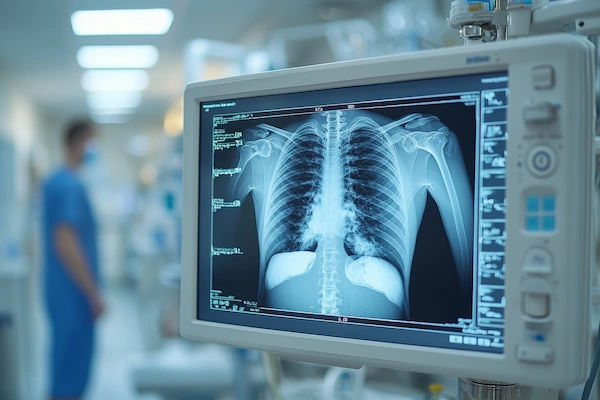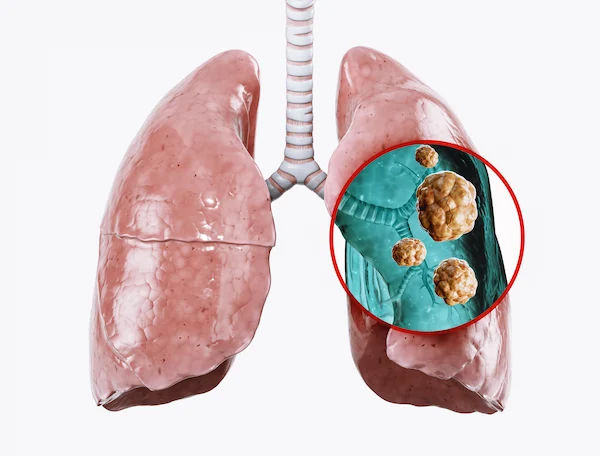Your Guide to the Radial EBUS Procedure; Diagnosis for Lung Nodules
Learn about the radial EBUS procedure, a minimally invasive method to diagnose lung nodules. Discover how it works, its benefits, risks, and recovery process.

.webp?tr=q-80,f-webp,w-350,dpr-2,c-at_max 700w)
Introduction
Discovering a spot or nodule on your lung scan can be worrying. Fortunately, modern medicine offers advanced, minimally invasive tools to investigate these findings without major surgery. One such breakthrough is the Endobronchial Ultrasound (EBUS) radial probe. This article is your comprehensive guide to understanding this sophisticated technology. We’ll break down what it is, how the procedure works, its significant benefits, and what you can expect if your doctor recommends it. By the end, you'll have a clear picture of how this tool provides a safer, more precise path to diagnosing lung conditions.
What is an Endobronchial Ultrasound (EBUS) Radial Probe?
An Endobronchial Ultrasound (EBUS) radial probe is a specialised medical device used during a bronchoscopy—a procedure where a thin, flexible tube (bronchoscope) is passed through the mouth or nose into the lungs. Unlike a standard bronchoscope that only has a camera, the radial EBUS probe incorporates a tiny ultrasound transducer at its tip. Think of it as giving your pulmonologist a special pair of "eyes" that can see through the airway walls to examine the surrounding lung tissue.
The Core Technology: Ultrasound at the Tip of a Catheter
The probe itself is incredibly thin, like a catheter, and is advanced through a channel in the bronchoscope. Once the bronchoscope is positioned in the larger airways, the probe is guided into the smaller branches leading to the area of concern, often a peripheral pulmonary lesion. The ultrasound transducer rotates 360 degrees, emitting sound waves that create a circular, real-time image of the airway and everything around it. This allows the doctor to visualise structures like blood vessels, lymph nodes, and most importantly, the precise location of the lung nodule.
A Key Difference: Radial EBUS vs. Linear EBUS
It's important to distinguish the radial probe from its cousin, the linear EBUS probe. While both use ultrasound, they serve different primary purposes:
- Radial EBUS: Provides a 360-degree view and is primarily used to diagnose peripheral lung nodules (those located away from the centre of the chest).
- Linear EBUS: Provides a sector-shaped view and is primarily used for staging lung cancer by sampling lymph nodes located next to the central airways (mediastinal lymph nodes).
In simple terms, radial EBUS is the scout that finds the small, hard-to-reach nodules, while linear EBUS is used to check if cancer has spread to nearby lymph nodes. Sometimes, both procedures are performed during the same session for a comprehensive evaluation.
Primary Uses: When is a Radial EBUS Probe Recommended?
Your pulmonologist might recommend a radial EBUS procedure for several key reasons, all centred on obtaining an accurate diagnosis with minimal discomfort.
Evaluating Peripheral Pulmonary Lesions (PPLs)
This is the most common application. When a CT scan reveals a small nodule or mass in the outer regions of the lung, it can be challenging to reach with traditional bronchoscopy. The radial EBUS probe acts as a GPS, allowing the doctor to navigate the complex bronchial tree and confirm they are right next to the lesion before taking a biopsy. This significantly increases the chances of a successful diagnosis.
Consult a Pulmonologist for the best advice
Guiding Transbronchial Lung Biopsies (TBLB)
For certain diffuse lung diseases (like sarcoidosis or pulmonary fibrosis), doctors need small samples of lung tissue rather than a specific nodule. A radial EBUS-guided transbronchial lung biopsy is much safer than a non-guided one. The ultrasound helps the physician avoid piercing blood vessels, drastically reducing the risk of bleeding.
Staging Lung Cancer and Assessing Airway Invasion
If a central tumour is suspected near a major airway, the radial probe can help determine if it has invaded the airway wall. This information is crucial for accurate staging and planning treatment, such as surgery or radiotherapy.
The Radial EBUS Procedure: A Step-by-Step Walkthrough
Knowing what to expect can ease anxiety. Here’s a typical timeline for a radial EBUS procedure.
Phase 1: Preparation and Anaesthesia
You will be asked to fast for several hours before the procedure. It is typically performed under conscious sedation or general anaesthesia, meaning you will be very sleepy and comfortable, often with no memory of the procedure. Your vital signs will be closely monitored throughout.
Phase 2: Navigation to the Lung Nodule
The doctor inserts the bronchoscope through your mouth. Using the CT scan as a map, they navigate the scope through your airways. Once in the general area, the thin radial EBUS probe is advanced beyond the scope's view. The real-time ultrasound image on the monitor guides the final, precise movements to locate the nodule.
Phase 3: The "Ultrasound Sign" and Biopsy
When the probe is directly adjacent to the target, the ultrasound screen shows a characteristic appearance of the lesion. This is the confirmation needed. The probe is then removed, and biopsy tools (like forceps or a needle) are passed through the same channel to collect tissue samples from the exact spot.
Phase 4: Recovery and Post-Procedure Care
The procedure usually takes 30 to 60 minutes. You'll wake up in a recovery area. You may have a mild sore throat or cough. Most patients can go home the same day after a short observation period. You will need someone to drive you home. Your doctor will provide specific instructions, such as avoiding food and drink for a couple of hours. The biopsy samples are sent to a pathology lab, and results typically take a few days. If you experience significant shortness of breath, chest pain, or coughing up more than a tablespoon of blood after returning home, seek immediate medical attention or consult a doctor online with Apollo24|7 for urgent advice.
Advantages of Choosing Radial EBUS
Why is this technology a preferred choice for diagnosing peripheral lung lesions?
Minimally Invasive with a High Diagnostic Yield
Compared to surgical procedures like VATS (Video-Assisted Thoracoscopic Surgery), radial EBUS is far less invasive. There are no incisions, leading to faster recovery, less pain, and lower risk of complications. Studies show it can have a diagnostic yield of over 70–80% for nodules greater than 2 cm, making it a highly effective tool.
Reaching Difficult Areas Safely
The primary advantage is its ability to safely access nodules that are unreachable by standard bronchoscopy. The real-time ultrasound visualisation helps avoid blood vessels, making the biopsy process much safer than non-guided techniques or CT-guided needle biopsies, which carry a higher risk of lung collapse (pneumothorax).
Potential Risks and Limitations
Like any medical procedure, radial EBUS has potential risks, though they are uncommon.
Understanding the Common Risks
These can include:
- Sore throat: Common but temporary.
- Bleeding: Usually minor at the biopsy site.
- Infection: Rare.
- Low oxygen levels during the procedure: Monitored and managed by the medical team.
- Pneumothorax (collapsed lung): A rare but more serious risk if the lung lining is punctured.
When Radial EBUS Might Not Be the Best Option
The procedure's success can depend on the nodule's size and location. Very small nodules (less than 1–2 cm) or those without a clear airway leading to them (an "airway sign" on CT) may be difficult to sample. In such cases, your doctor might discuss alternative options.
Preparing for Your Radial EBUS Procedure
Your healthcare team will give you specific instructions, which generally include:
- Fasting: Typically no food or drink for 6–12 hours before.
- Medications: Inform your doctor about all medications, especially blood thinners (like aspirin, warfarin), which you may need to stop temporarily.
- Arrangements: Plan for someone to drive you home and stay with you for the first evening.
- Health History: Discuss any allergies, previous surgeries, or other health conditions.
Conclusion
The development of the endobronchial ultrasound radial probe represents a significant leap forward in pulmonary medicine. It transforms the diagnostic journey for patients with lung nodules from one of uncertainty and potential invasiveness to a more precise, safer, and efficient process. By providing a clear view of what lies beyond the airway walls, it empowers doctors to make accurate diagnoses with minimal impact on the patient's quality of life. If your doctor has suggested this procedure, you can be assured that you are benefiting from one of the most advanced tools available in modern interventional pulmonology. Always discuss any concerns or questions directly with your healthcare provider to ensure you are fully prepared and comfortable with your treatment plan. If you have a lung nodule that needs evaluation, consulting a specialist through Apollo24|7 can help you understand if a radial EBUS procedure is the right next step for you.
Consult a Pulmonologist for the best advice
Consult a Pulmonologist for the best advice

Dr. Mahavir Bagrecha
Pulmonology Respiratory Medicine Specialist
14 Years • MBBS, MD (PULMONOLOGY)
Pune
Swash Chest and Diabetes Clinic, Pune
(50+ Patients)

Dr. Sai Praveen Haranath
Pulmonology Respiratory Medicine Specialist
24 Years • MBBS, AB (Int. Med.), Pul. & Critical Care Med., MPH, FCCP
Hyderabad
Apollo Hospitals Jubilee Hills, Hyderabad
(25+ Patients)

Dr Abhishek Verma
Pulmonology Respiratory Medicine Specialist
5 Years • MD (Respiratory Medicine), PDCC (Interventional Pulmonology) Alumni SGPGIMS & KGMU Lucknow
Lucknow
Apollomedics Super Speciality Hospital, Lucknow
(50+ Patients)

Dr. S Mallikarjun Rao
Pulmonology Respiratory Medicine Specialist
22 Years • MBBS, MD (Pul.), FCCP
Hyderguda
Apollo Hospitals Hyderguda, Hyderguda
(75+ Patients)

Dr. Ajay Joy K
Pulmonology Respiratory Medicine Specialist
7 Years • MBBS, MD (Pulmonary Medicine)
Angamaly
Apollo Hospitals Karukutty, Angamaly
Consult a Pulmonologist for the best advice

Dr. Mahavir Bagrecha
Pulmonology Respiratory Medicine Specialist
14 Years • MBBS, MD (PULMONOLOGY)
Pune
Swash Chest and Diabetes Clinic, Pune
(50+ Patients)

Dr. Sai Praveen Haranath
Pulmonology Respiratory Medicine Specialist
24 Years • MBBS, AB (Int. Med.), Pul. & Critical Care Med., MPH, FCCP
Hyderabad
Apollo Hospitals Jubilee Hills, Hyderabad
(25+ Patients)

Dr Abhishek Verma
Pulmonology Respiratory Medicine Specialist
5 Years • MD (Respiratory Medicine), PDCC (Interventional Pulmonology) Alumni SGPGIMS & KGMU Lucknow
Lucknow
Apollomedics Super Speciality Hospital, Lucknow
(50+ Patients)

Dr. S Mallikarjun Rao
Pulmonology Respiratory Medicine Specialist
22 Years • MBBS, MD (Pul.), FCCP
Hyderguda
Apollo Hospitals Hyderguda, Hyderguda
(75+ Patients)

Dr. Ajay Joy K
Pulmonology Respiratory Medicine Specialist
7 Years • MBBS, MD (Pulmonary Medicine)
Angamaly
Apollo Hospitals Karukutty, Angamaly
More articles from Lung Cancer
Frequently Asked Questions
How painful is a radial EBUS procedure?
You will be under sedation or general anaesthesia, so you should not feel any pain during the procedure. Afterwards, a mild sore throat or cough is common but manageable.
What is the recovery time after a radial EBUS biopsy?
Most people feel well enough to return to normal activities within 24 hours. Your doctor may advise avoiding strenuous exercise for a day or two.
How accurate is radial EBUS in diagnosing lung cancer?
For appropriately selected nodules, the diagnostic accuracy is high, often cited between 70% and 90%, depending on the nodule's size and location.
What are the alternatives to radial EBUS for a lung nodule?
Alternatives include CT-guided needle biopsy (higher risk of pneumothorax) or surgical biopsy (VATS), which is more invasive but can both diagnose and remove the nodule in one step.
Is radial EBUS covered by insurance?
Yes, as a medically necessary diagnostic procedure, it is typically covered by most health insurance plans. It's always best to check with your provider beforehand.



.webp)
